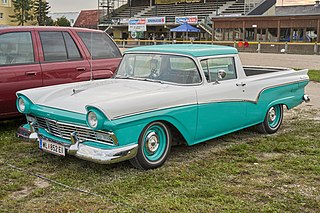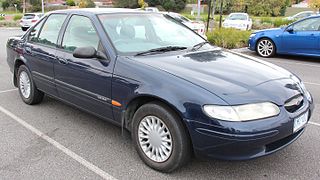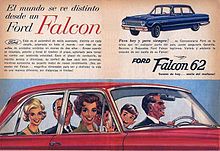
The Ford Sierra is a mid-size car or large family car manufactured and marketed by Ford Europe from 1982–1993, designed by Uwe Bahnsen, Robert Lutz and Patrick le Quément — and noted for its aerodynamic styling producing a drag coefficient of 0.34, a significant improvement over its predecessors.

The Ford Ranchero is a coupe utility that was produced by Ford between 1957 and 1979. Unlike a standard pickup truck, the Ranchero was adapted from a two-door station wagon platform that integrated the cab and cargo bed into the body. A total of 508,355 units were produced during the model's production run. Over its lifespan it was variously derived from full-sized, compact, and intermediate automobiles sold by Ford for the North American market.

The Ford Laser is a compact car, originally a subcompact car in the first three generations, which was sold by Ford in Asia, Oceania, and parts of South America and Africa. It has generally been available as a sedan or hatchback, although convertible, wagon and pick-up versions have also been available in different markets. The sedan, and briefly station wagon, versions were badged Ford Meteor in Australia between 1981 and 1987. The Ford Meteor name was also used in South Africa.

The Ford Telstar is an automobile that was sold by Ford in Asia, Australasia and Africa, comparable in size to the European Ford Sierra and the North American Ford Tempo. It was progressively replaced by the Ford Mondeo. The car was named after the Telstar satellite.

The Ford Falcon is a full-size car that was manufactured by Ford Australia from 1960 to 2016. From the XA series of 1972 onward, each Falcon and range of derivates have been designed, developed, and built in Australia, following the phasing out of the American-influenced Falcon of 1960 to 1971, which had been re-engineered locally as the XK to XY series for the harsher Australian conditions. The luxury-oriented Ford Fairmont model joined the range from 1965. Luxury long-wheelbase derivative versions called the Ford Fairlane and LTD arrived in 1967 and 1973 respectively with production ending in 2007.

The Volkswagen Santana is a nameplate used by Volkswagen for various sedans and station wagons since 1983. The first generation is based on the second-generation Volkswagen Passat (B2). It was introduced in 1981 while production started in 1983 for China. The use of the "Santana" badge rather than "Passat" echoes the use of different names for the sedan versions of the Polo (Derby) and Golf (Jetta).

The Ford Territory is a mid-size crossover SUV built by Ford Australia that was introduced in April 2004 and produced until 7 October 2016. It was the only SUV built in Australia and Ford's first large three-row crossover SUV. It was originally based on the EA169 platform introduced by the EA Falcon and its internal project codename was E265. It won various automotive awards and was the first SUV to win the Australian title of Wheels Car of the Year in 2004, due to its acceptable handling and child carrying capacity.

The Ford Galaxy is a seven-seater car produced by Ford of Europe from June 1995 to April 2023. Considered in the motor industry to be a large multi-purpose vehicle (MPV), it was the first Ford-brand MPV produced and marketed outside of North America, the model line is currently in its third generation. Sharing its platform architecture with the Ford Mondeo, the Galaxy was developed alongside the Ford S-Max; the model line is slotted between the Connect and Custom variants of the Ford Tourneo/Transit model family.

The Ford Fairlane is an automobile model that was sold between the 1955 and 1970 model years by Ford in North America. Taking its name from the Dearborn, Michigan estate of Henry Ford, the Fairlane nameplate was used for seven different generations of vehicles. Through its production, the model line would be marketed in a wide variety of body styles, including two-door and four-door sedans, two-door and four-door hardtops, station wagons, and both traditional and retractable-hardtop convertibles.

The Ford Falcon is a model line of cars that was produced by Ford from the 1960 to 1970 model years. Though preceded by the Rambler American, the Falcon was the first compact car marketed by the Big Three American manufacturers.

The Ford Falcon (BA) is a full-sized car produced by Ford Australia from 2002 to 2005. It was the second significantly re-engineered iteration of the sixth generation of the Falcon, and also included the Ford Fairmont (BA)—the luxury-oriented version. This platform also formed the basis of the Ford Territory sport utility vehicle.

The Ford Falcon (AU) is a full-size car that was produced by Ford Australia from 1998 to 2002. It was the sixth generation Ford Falcon and also included the Ford Fairmont (AU)—the luxury-oriented model range. The AU series replaced the EL Falcon and was constructed on the (at the time) new EA169 platform which continued to harbour Falcon models until 2010 when the BF wagon was discontinued, and Ford Territory models until 2011. The AU series was replaced by the updated BA series.

The Ford Falcon (EL) is a full-size car that was produced by Ford Australia from 1996 to 1998. It was the fifth and final iteration of the fifth generation of the Falcon and also included the Ford Fairmont (EL)—the luxury-oriented version.

The Ford Falcon (EF) was a full-size car that was produced by Ford Australia from 1994 to 1996. It was the fourth significantly updated iteration of the fifth generation of the Falcon and also included the luxury-oriented Ford Fairmont (EF).

The Ford Falcon (ED) is a full-size car that was produced by Ford Australia from 1993 to 1994. It was the third iteration of the fifth generation of the Falcon and also included the Ford Fairmont (ED)—the luxury-oriented version.

The Ford Fairmont is a full-size car that was built by Ford Australia as an upmarket model of the Ford Falcon from 1965 to 2008. It featured a higher level of standard equipment than corresponding Falcon models of the same series. As well as offering a more luxurious interior trim with additional comfort and convenience features, for much of its first 25 years the Fairmont also offered a higher mechanical specification; a larger capacity engine and refinements such as disc brakes, power steering and automatic transmission that were extra cost options for the Falcon were fitted as standard equipment for the Fairmont. It was available as a four-door sedan throughout its life, as a five-door station wagon from its introduction through to 2002, and as a two-door hardtop from 1972 to 1978.

The Ford Falcon (XM) is a mid-size car that was produced by Ford Australia between February 1964 and February 1965. It was the third iteration of the first generation of the Ford Falcon.

The European Ford Granada is an executive car manufactured by Ford Europe from 1972 until 1994.

The Ford Falcon (XF) is a full-sized car that was produced by Ford Australia from 1984 to 1988. It was the third iteration of the fourth generation of the Falcon and also included the Ford Fairmont (XF)—the luxury-oriented version. Between 1993 and 1999, this series provided the platform for the Falcon utility (XG and XH) that was sold alongside the fifth-generation Ford Falcon sedans and wagons.

The Ford Mondeo Mk IV (third generation), codenamed CD345 was officially unveiled in five-door production form by Ford in late 2006. Based on the EUCD platform developed with Volvo, the platform was the same as that used in the new large MPVs Galaxy and S-MAX, but not the North American Ford Fusion or the Mazda Atenza in Japan. It was also used for several Volvos starting with the Volvo S80 II.


























